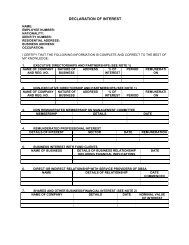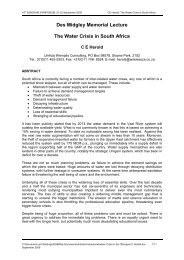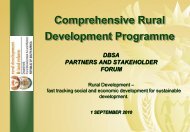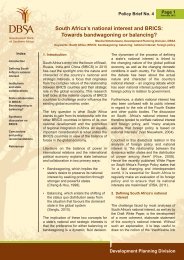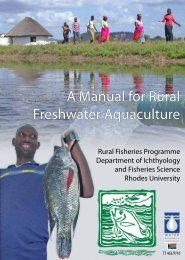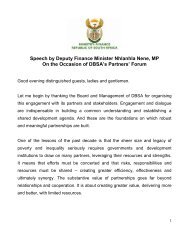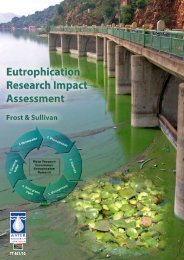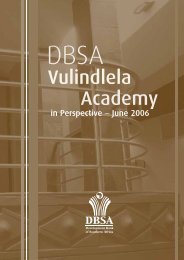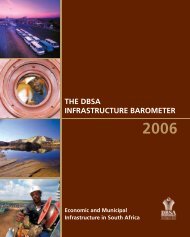Building education beyond crisis.pdf
Building education beyond crisis.pdf
Building education beyond crisis.pdf
You also want an ePaper? Increase the reach of your titles
YUMPU automatically turns print PDFs into web optimized ePapers that Google loves.
<strong>Building</strong> Education Beyond CrisisBy Graeme Bloch, Education Policy Analyst,Development Bank of Southern Africa (DBSA)graemeb@dbsa.orgGraeme Bloch: <strong>Building</strong> Education Beyond Crisis: Development Today 1
The point of such propositions is not to needlessly generalise or to lay blame, ormerely to highlight the complexity of change. Minister Pandor herself has publiclyidentified many of the key points of weakness. In a low key but directed way, sheand her staff in the Department under the new Director General Duncan Hindle,have set about a consolidation and re-focusing of official energies.They have turned the spotlight on the need for stabilisation and the hard graft tofocus on core areas of intervention that may make a difference, that will bringlong-term gains and that will have wider spin-off effects in moving towards quality<strong>education</strong> for all. Many departmental programs exist that address the problemslisted.Enhancing the understanding of problem areas, however, to identify strengthsand possibilities, and to determine interventions that are creative and innovativeat the same time will surely enhance the efforts of the Department to improve<strong>education</strong> at all levels.It can be said that in terms of a number of key indicators, the <strong>education</strong> system isfailing to make the grade. This finds expression in relatively poor outcomes.Basic reading scores, and maths and science literacy, are consistently amongstthe world‘s worst, including much of Africa. Recent scores showed that only 20%of 6 th -graders could do maths at the appropriate grade levels (average score27%) and only 40% in language of instruction (average score 38%) (IOL12/12/2005).But more alarming are the disparities amongst schools. In one 2001 study, where65% of children in model C (ex-white) schools saw appropriate scores at 6 thgrade level, the figure for ex-DET (black) schools was only 0,1%. This isconfirmed recently where the average score for 6 th grade maths in the lowest feepayingschools (under R100) where some 72% of children are located, was 22%.Only some 5% of students do higher grade maths and science for matric whilethe matric exemption rate is static or falling at 17%.In general, probably some 50% of learners do not even make it through theschool system and drop out before completion, with one recent study claimingonly 32% of 2003 grade 10s actually passed (Business Day 11/01/2006).Surveys talk about an overwhelming sense of sadness amongst the youngunemployed, and circles of doom that reinforce their marginalization and lack ofhope.Where students should expect opportunities and assistance, they find their hopesand dreams crumbling before their eyes, and face obstacles rather than laddersto progress and self-esteem.Graeme Bloch: <strong>Building</strong> Education Beyond Crisis: Development Today 3
This reflects the reality that <strong>education</strong> is failing some 80% of school-age children,who find themselves trapped in sinkholes of unemployment and poverty ratherthan on tracks to autonomy and possibility. At their worst, many township andrural schools have been described as sinkholes, where children are ‗warehoused‘rather than educated.Education is contributing to marginalisation and inequity rather than socialadvance and cohesion for many, especially the poor and rural.In the context of a wide range of social hinge points – unmet democraticexpectations; availability of resources; social and class divisions; dissatisfactionwith the pace and quality of delivery – such failure of <strong>education</strong> could spelldisaster for South Africa.2. The Importance of Skills.Education and skills training are indeed seen by government as pillars of thedevelopmental state in at least two spheres, in terms of developing and growingthe economy, and in relation to social cohesion (Soudien, 2005).The recent 2006 Budget Review argues ―A core priority is to strengthen<strong>education</strong> and improve performance on the labour market. Investing in peopleand ensuring that skills development complements employment creation arecritical platforms on which to build future prosperity.‖ (102)The same report notes that ―highly uneven <strong>education</strong> and training systems‖ areone of the barriers to growth (Treasury 2006, 102).Treasury further argues that :―The uneven quality of schooling, weaknesses in <strong>education</strong> administration,differentiated qualifications and salaries of teachers, and inadequacies in skillsdevelopment have to be addressed as part of South Africa‘s strategy forsustained growth and poverty reduction‖ (106).Indeed, in relation to the economy, the reality is that the current restricted skillsproduction is likely to impact negatively. This is a clear bottleneck on attempts togrow at 6%, to enhance infrastructure development or to ensure sustainablegrowth, especially in a way that addresses the poverty imperative.South Africa is a country on the brink of expanded growth – and the currentproduction of high level skills is insufficient to meet the stresses and demands.Furthermore, in a country with great expectations of equity, <strong>education</strong> is failing tomake the grade in a way that particularly impacts on poor, rural and townshipschools. It could be argued that for 60 to 80% of children, <strong>education</strong> reinforcesGraeme Bloch: <strong>Building</strong> Education Beyond Crisis: Development Today 4
marginalization, condemning them to a second economy of unemployment andsurvival.There is an urgent pressure to find new spaces to engage the harsh realities andunexpected complexities of change in brave new South Africa. Theseinterventions need to be based on careful analysis and understanding of the keyissues.Many of the complexities lie deep in the inheritance from apartheid <strong>education</strong>.Below, the background and main features of <strong>education</strong> in South Africa areconsidered.3. Background and History: Apartheid’s InheritanceThree aspects of the inheritance from apartheid <strong>education</strong> are important.Firstly, the roots of the current system and its many systemic weaknesses, lie inthe faulty, destructive pedagogic and ideological processes of Bantu Educationand its sibling, Christelike Nasionale Onderwys (CNO). This left a legacy ofinequality, poor physical and human infrastructure, and a racially divided andcontested system. While there was an increasing massification at both thesecondary and even higher <strong>education</strong> levels after the 1976 uprisings, this wastied to severely constrained political, social and economic opportunities forblacks.Secondly, opposition to <strong>education</strong> impositions also led to a deep tradition of<strong>education</strong> struggles and the building of alternatives. Much has been written onthe negative effects of school boycotts and the impacts on the culture of learningand teaching in the 1980s and 1990s. It is also important to stress a strain ofthinking that placed high value on <strong>education</strong> and its outcomes and oftendeveloped a more utopian and aspirational set of alternatives. The high-point ofthese was captured in the People‘s Education movement under the banner of theNECC, later translated into the NEPI (National Education Policy Initiative)processes that tried to give more policy flesh as South Africa entered thetransition period of democratic government.A third historical point relates to the international context and the transition periodof the 1990s with its political and technical compromises. The sweep ofglobalisation and end of the Cold War foreclosed many policy options.Implications ranged from fiscal limitations to marketised solutions that putpressure on the role of the state.The growth of global knowledge-based economies underlined the need forstrategies to foreground high-level skills competitive on the global stage. At thesame time, the effects of globalisation are often to marginalise and degradeGraeme Bloch: <strong>Building</strong> Education Beyond Crisis: Development Today 5
lower-level skills and occupations as economic sectors collapse under thecompetitive pressures of low-wage economies such as China. Marginalisationand high levels of unemployment in South Africa are captured in the shorthandnotation of the second economy with its many poverty traps.The effects of these processes are uneven and varied. As Kraak argues:―The concept of a national economy is often read in simplistic terms as a singlemonolithic entity...Such a monolithic view masks several (multi-layered)processes of economic differentiation and segmentation. …There are three skillsbands associated with three differentiated economic sectors that are structurallyseparated by their varying production regimes, technology needs, productmarkets and skills utilization…referred to as the high, intermediate and low skillsbands.‖ (Kraak, 2004, 65)The changed global context, overlaid on the inflexibility and inefficiencies ofapartheid <strong>education</strong>, spelt difficulties indeed for any transition and the emergenceof sustainable and developmental <strong>education</strong> options.Thus, it is crucial to acknowledge the complexity of <strong>education</strong>. Everybody whohas been to school thinks they have the solution. Yet <strong>education</strong> is deeplyembedded in history, the social and economic past and present. It means thatsolutions cannot be simple; and it also implies that there are very few quick fixes.Unravelling this puzzle, will take much work, thinking, organizing, and great effortto build consensus and direction around core priorities.Further, it is clear that many of the problems are hardly of schooling‘s making.Thus, malnutrition, hunger, poverty, AIDS, child abuse, criminal gangs, lack ofbooks or people to assist at home, all impact on what happens in the classroom,and are all areas that may be difficult terrains for decisive intervention by(<strong>education</strong>al) authorities, certainly acting in isolation.4. History: Achievements of DemocracyIn this context, it is absolutely true to say that here have been significantachievements in turning around apartheid <strong>education</strong> in the first ten years ofdemocracy.Not least, is a consequence of primary <strong>education</strong> being made compulsory: theMDGs for <strong>education</strong> have already been achieved in South Africa. Both levels ofuniversal primary <strong>education</strong> and the gender balance in schools go <strong>beyond</strong> therequirements and targets set to be achieved by 2015.Further achievements include the amalgamation and unification of the variousapartheid <strong>education</strong> systems and Bantustan establishments into a single nationalDepartment responsible for broad policy and the provincial establishmentsGraeme Bloch: <strong>Building</strong> Education Beyond Crisis: Development Today 6
esponsible for delivery. The SA Schools Act of 1996 laid the basis for a nonracialapproach to <strong>education</strong> with common norms and standards for all. Therewere strides towards equalizing expenditure across the racial divides as well asdealing with issues such as size of classes, access to teachers and coursematerials, and so on. This has been followed by a raft of policy papers, reports,legislation, implementation directives and institutional development that showprogress across many branches of <strong>education</strong> from higher to vocational.Within the fiscal landscape – and despite the strictures of GEAR - there has beena massive emphasis and priority on the <strong>education</strong> budget with some 6% of GDPand approx 21% of the national budget being allocated at its height (althoughqualified below). There were 26 845 ordinary schools in 2003, with some 12 038922 learners and 362 598 educators (DoE 2005) and a budget of some R65bn.The syllabus has had to be re-designed and re-written for the democraticscenario, underlaid by the progressivist assumptions of OBE (Outcomes BasedEducation) with its learner-based and critical teaching strategies as laid out inCurriculum 2005. At the outcomes levels, a strong focus by the second Ministerof Education Kader Asmal saw matric results improved from a poor 58% pass in1994 and worse 47,4% in 1997 to 73,3% in 2003.Looking at the Senior Certificate results in 1994, 495 408 wrote, rising to 552 384in 1998. 88 497 attained exemption (18%) in 1994 dropping to a low of 63 725 or12% in 1999. In 2003, out of 440 096 who wrote the exam, 26,7% failed, 54,6%passed without endorsement and 82 010 or 18,6% with endorsement..Some 508 363 learners wrote in 2005, up from 495 408 in 1994. A moderateincrease of numbers passed, up to 347 184 from 287 343 in 1994, and 16 500more than in 2004 despite a slightly lower pass rate at 68,3%. Numbers passingmaths and science on higher grade improved marginally. A disappointment hasbeen the falling rate of matric exemptions, at just around 17%. While 82 010attained endorsement in 2003, 85 117 in 2004 and 86 531 in 2005, this is stillfewer than the 88 497 in 1994.There have been dramatic institutional changes in the Higher Education and FETCollege landscape. 120 Colleges of Education (teacher training) have beenmerged into university <strong>education</strong> departments in an attempt to improve qualityand critical approaches. In addition, the Higher Education scene has seen 36institutions merged into 21 universities and universities of technology, and some150 FET colleges reduced to 50 through the 1998 FET Act.Black student enrolment at universities and technikons grew from 191 000 in1993 to 343 000 in 1999 (81%) to 449 000 in 2003 (including distance 717 793).Black students made up 59% of university headcount in 1999 and 64% in 2003,the figure being 86% for technikons. 53% were women.(Jansen 2004, 330; DoE2005). The National Student Financial Aid Scheme (NSFAS) has expanded to aGraeme Bloch: <strong>Building</strong> Education Beyond Crisis: Development Today 7
R985m scheme in 2004 from R70m in1994, with some 114 000 beneficiaries (28000 in 1994).What these figures show is that, despite massive challenges of transformation,there is clearly a positive continuity in the school and wider <strong>education</strong> system.There are important levels of stabilization and delivery and there is a cohort ofstudents who are managing to attain high levels of achievement.5. Analysing the problemsThese gains, unfortunately, need to be offset against significant problems. Theproblems become more important in the context of the searing competitivedemands of global competition, and the local context of deep inequalities andpoverty traps faced especially by poor and rural citizens in the second economy.If there is one phrase that summarizes the failings of the <strong>education</strong> system, it is―poor quality‖. In failing to achieve quality delivery, the <strong>education</strong> system isworking only for a proportion of the learners who are able to access the relevantinstitutions. For a majority, lack of quality <strong>education</strong> dooms them tomarginalisation and exclusion from the schools, universities and colleges thatshould give them access to a better life. Put harshly and in a pointed form,<strong>education</strong> tends to reinforce the social and economic marginalisation of the poorand vulnerable in South Africa, and reinforces their position at the survival end ofthe second economy with few prospects for movement or further development.Some of the core concerns on the supply side of the <strong>education</strong> landscapeinclude:5.1 Poor teacher supportIf what goes on in the classroom is the key to learning, it is at this level that therehave been the greatest failures. Teachers have suffered the most from theeffects of policy overload and the failure to ask crucial micro-level questions as towhat could enhance classroom success. Many skilled teachers were lost duringan ill-advised ‗retrenchment‘ process.Teacher morale is generally low with flight overseas or to other professions - overhalf express the desire to leave and relations with the departments are oftenantagonistic. It is clear that the move of teacher training to universities has hadthe paradoxical effect of making it less accessible to poor students, whileteaching has become a less than desirable occupation for bright studentsseeking opportunities in the new South Africa.Some of these conditions are embedded in the sociology of apartheid teachers .For many years teaching (and nursing and social work) was the only aspirationand opportunity for ―middle-class‖ blacks. Today, some teachers have ‗escaped‘Graeme Bloch: <strong>Building</strong> Education Beyond Crisis: Development Today 8
into bureaucracies, into new jobs or running their own companies – is itsurprising that many of those left behind feel resentment or dis-ease? Newopportunities for young blacks now mean the brightest and best aspire to a widerworld, and again are reluctant to join the ranks of low-paid educators inuninspiring situations with unsure prospects. Some 80% of teacher trainees arewhite, some two thirds are women – a demographic with stark implications fortownship schools and mother tongue teaching.5.2 Curriculum complexityThe complexity of Outcomes-Based Education (OBE) as embodied in Curriculum2005 has been a disaster for teachers, requiring levels of skill and experiencethat only exist among the best teachers, as well as access to resources noteasily available, say in rural contexts. The complex qualifications-based SAQAsystem has not even been piloted in more settled <strong>education</strong>al contexts and wasin hindsight hopelessly idealistic as even the key progenitors have noted. Thework-based SETA system has struggled to find its feet and been criticized forbeing needlessly bureaucratic and difficult. Many of these difficulties have beenrecognized in the different way the DoE has introduced revised versions ofcurriculum for the new FET Certificate (senior school), with widespread prepublicityand attention to teacher support and appropriate materials.5.3 Disjunctures and mismanagementNot only are there key policy slippages, for example between the <strong>education</strong> andtraining (labour) systems, or between the various branches of the Department ofEducation, but the very structure of the relationship between national (policy)department and provincial (delivery) departments leads to highly unequal andinconsistent outcomes. At provincial and district level, while there have beenmany improvements (e.g. security and marking of scripts; delivery of textbooks)there are also woeful tales of mismanagement and maladministration as well assimply poor levels of support infrastructure to schools. Rural provinces such asMpumulanga, Eastern Cape and KZN continue to be sites for <strong>education</strong>aldisadvantage of their learners. Even money set aside for capital improvements isunspent, with some R2bn of R12bn unspent in 2003/4.Furthermore, the system of block grants to provinces has seen a declining<strong>education</strong> spend overall, reducing to low-points of some 4,7% of GDP from ahigh of over 6%.The higher <strong>education</strong> system has found itself squeezed by new demands and astudent body neither academically nor financially well-endowed. It has had tomake do with unsatisfactory resources and inconsistent and short-termistfinancing.Graeme Bloch: <strong>Building</strong> Education Beyond Crisis: Development Today 9
Then, there have been ‗policy breaches‘. While Minister Bengu‘s priorities wererestructuring and de-racialising, can he really be blamed for the progressivistoptimism that saw the introduction of OBE (Outcomes Based Education) and itsmassive failures amongst poorly resourced schools and teachers? Similarly,Minister Asmal‘s focus on matric results and high-profile victories, while driven toraise morale, failed to bed down the long-term pathways that were required. Hisstraight-talking perhaps only heightened the tendency of relations with theteacher unions to become conflict-based labour relations rather than a process ofmutual professional development.5.4 Governance and leadershipSystems of school governance were based on many of the idealistic assumptionsof the people‘s <strong>education</strong> movement that stressed the importance of communitymobilization and involvement in <strong>education</strong> issues. The hoped for momentum hasnot transpired. Indeed, while the Schools Governing Bodies (SGBs) of many ofthe Model C (old white) schools have been able to raise substantial private fundsand skills to improve <strong>education</strong> provision, there have been accusations that insome cases this has involved maintenance of privilege and restricted access. Onthe other hand, in poorer communities, SGBs have sometimes been a source oflocalized power politics and resource control. The DoE has also re-visited thequestion of the powers of principals in this environment in a bid to focus onissues of effective school leadership.Some of the more worrying outcomes of the weaknesses listed above include:5.5 Two systemsWhile formerly white Model-C schools produce uniformly better results, rural andtownship schools overwhelmingly survive through sheer will and the force ofgood and committed teachers. Hours on the job are substantially less in ‗secondeconomy‘schools. Over half of the cohort that starts school never gets to theend, with Grade 9 being a major point of drop out. Evidence has shown thatenhancing resource inputs, surprisingly, seems to have little effect on outcomesin poorer schools. It is not (only) money or even physical infrastructure that isimportant, but how the <strong>education</strong> process is ordered, managed and translatedinto classroom practice. The result for those in such hostile and bleakenvironments, has often been teacher brain drain and student flight or desertionfrom township schools where possible. Only a small number of black studentsacquire an <strong>education</strong> of any meaningful quality - there is a huge gap between thetop quintile of learners and the rest. Poor schools effectively play a warehousingfunction or have become ‗sinkholes‘, with some notable exceptions. In short, ruraland poor schools effectively form a second system of <strong>education</strong>, trappingparticipants behind the massive blocks of the second economy.5.6 Skills backlogsGraeme Bloch: <strong>Building</strong> Education Beyond Crisis: Development Today 10
Comparative scores for maths, numeracy and literacy are consistently among theworst in the world. While skills at the top end may be cutting-edge, there is justnot the broad base to ensure adequate responsiveness to the changingpressures of globalisation and the knowledge economy.Recent national tests showed that while some 65% of 6 th -grade learners in modelC schools performed at 6 th grade level (not great), this figure was some 3% in ex-DEC schools and a frightening 0,1% in ex-DET schools.Recent scores showed that only 20% of 6 th -graders could do maths at theappropriate grade levels (average score 27%) and only 40% in language ofinstruction (average score 38%) (IOL 12/12/2005). The average score for 6 thgrade maths in the lowest fee-paying schools (under R100) where some 72% ofchildren are located, was 22%. Only some 5% of students do higher grade mathsand science for matric while the matric exemption rate is static or falling at 17%.Numbers matriculating are no greater than in 1994, with similarly poor highergrade maths and university-exemption passes. Most learners are simply beingwarehoused rather than taught. These issues impact at the higher <strong>education</strong>level, where poor school results mean poor university preparation, high dropoutrates and the ‗revolving-door‘ syndrome. Where poor students do gain access<strong>beyond</strong> high-school, they struggle for academic support and adequate financingwhen costs such as residence and materials are included. Paradoxically, thenarrow funnel that so successfully filters access, ensures great pressures tosecure admission to one of the few avenues for progress.Further, the structure of researchers in the Science and Technology fields,including human sciences, is becoming increasingly old and remains largelywhite. While younger black graduates choose other lucrative professions overacademia, research and teaching, there are worrying implications for both pureand applied research in the future.5.7 UnemploymentThese systemic problems are compounded by the high levels of unemployment,in particular amongst youth. Where <strong>education</strong>al effort is not seen to lead toimproved life prospects, where even access to further <strong>education</strong> and trainingbecomes a financial and <strong>education</strong>al battle with poor prospects, the value of<strong>education</strong> risks rapidly losing its cachet. This can be seen in the ‗degrading‘ ofmatric results even as pass levels have improved. There is even a small level ofgraduate unemployment that points to the problems of the mismatch of skills withopportunities.Graeme Bloch: <strong>Building</strong> Education Beyond Crisis: Development Today 11
A range of ‗external‘ factors may impact on <strong>education</strong>, from HIV/AIDS (infectedteachers and learners, child-headed households) to poor nutrition and housing,to lack of facilities such as sportsfields or libraries.6. What Is to be Done?What is to be done in what is clearly a mixed picture, but one with decidedlybleak undertones?It is clear that <strong>education</strong> is in trouble, whether one uses the word ‗<strong>crisis</strong>‘ or not.The scale of marginalization and drop out is unacceptable. While even inEngland, the Audit Office found 25% of schools were not performing, while SouthAfrica can proudly note the achievement of the Millennium Development Goals(MDGs) for primary and gender enrolment, nonetheless the problems are indeeddeep.The first step is to engage with centres of excellence, the many places in thesystem where things are working. We need to find out why, andhow, and put in place measures to enhance and support these best-practiceresources.Take the example of the Piet N Aphane High School, an Impumelelo Awardsprizewinner: Piet N Aphane High School (Headmaster Mr MA Moloto) is situatedin Magatle Village, near Lebowakgomo in rural Limpopo. This year it celebratesits tenth anniversary. Its slogan, "Hard work pays dividends", is reflected aboveall in two things.Their matric results have improved from a dismal pass rate of 18 per cent in 1998to 91 per cent in 2003. The pass rate is now in the high 80s. Through creativefundraising they have a science and biology lab, and will soon have a mediacentre and a home economics centre "which is today known as TechnologyCentre and permakitchen". A range of academic streams and active sports clubscomplement a programme of visits that has taken learners as far afield asRobben Island, the Pretoria Police Museum and KwaZulu-Natal sugarfields"where we learnt a lot about science and biology". Students enter Olympiads andat least 6 are on school tertiary bursaries.Yet, the main object of the school‘s pride is its vegetable gardens, and sites forperma-culture and agro-forestry. Not only do they supply and train surroundingschools, but the post office, police, clinics and others have benefited. Boreholes,"rain harvesting", and a whole environmental policy have enthused and mobilisedthe village.In the school‘s own words, "(We congratulate you) for wanting to know moreabout what is happening in schools. Piet N Aphane never said that ‗Manna willcome from Heaven‘. Piet N Aphane has had to be an early bird that caught theGraeme Bloch: <strong>Building</strong> Education Beyond Crisis: Development Today 12
fattest worm since 1994. And we don‘t have a community or SGB (SchoolGoverning Body) serving like an opposition party. However, we achieve all thesethrough team work, hard work, as the motto of our school says, throughsacrificing our time, e.g. coming to work even during the holidays and weekends;and over and above all conveying our efforts to the Celestial Surgeon (God)".What happens at the school level and in the classroom is crucial. It is quite clearthat concerted school leadership, discipline, and cooperation amongst thevarious stakeholders involved at school level, can make a significant differenceeven in the poorest schools. Tied to good leadership must also be a campaign toempower and encourage teachers to do what is necessary: from enhancingskills, district-level support, access to materials, to issues such as discipline andtime-on-task.Min. Pandor is right to stress the importance of resource conditions — or lack ofthem — in schools. It is not just collapsing classrooms or lack of toilets orelectricity and telephones, but also issues such as libraries, laboratories andsportsfields, so that schools can begin to be whole places of social and individualdevelopment for communities and their children.If the nation is to get that right it is absolutely crucial to mobilise a great societywideconsensus around <strong>education</strong>al goals and priorities. Neither the ‗blamegame‘nor ideological solutions will help. While many things can be fixed in theshort-term, it will take a massive medium-term effort by all South Africans to rallyaround and intervene to find solutions.The ‗listening‘ stance of Pandor and her department is a good start, but it needsto be translated into decisive consultations, broad consensus, and firm prioritisedaction.Perhaps it is time for some sort of get together, where South Africans canacknowledge the depth and nature of the problem, where they can listen and refocus,and develop long-term plans that can help re-prioritise energies to producethe <strong>education</strong>al outcomes South Africa needs.The future of the country and its children depends on making the <strong>education</strong>system work.Graeme Bloch: <strong>Building</strong> Education Beyond Crisis: Development Today 13
Bibliography1. Chisholm, L (2005) ―The State of South Africa‘s Schools‖ in Daniel, JSouthall, R and Lutchman, J (eds) State of the Nation: South Africa 2004-2005. Cape Town: HSRC.2. Chisholm, Linda (2003) ―The state of curriculum reform in South Africa:The issue of Curriculum 2005‖ in Daniel, J Habib, A and Southall, R (eds)State of the Nation South Africa 2003-2004. Cape Town: HSRC.3. Chisholm, Linda (ed) (2004) Changing Class: Education and SocialChange in Post-Apartheid South Africa. Cape Town: HSRC.4. Chisholm, Linda Motala, Shireen and Vally, Salim (eds) (2003) SouthAfrica: Education Policy Review. Sandown: Heinemann.5. Council on Higher Education (2004) South African Higher Education in theFirst Decade of Democracy. Pretoria: CHE.6. Department of Education (2005) Education Statistics 2003. Pretoria: DoE7. DoE (2005) National Framework for Teacher Education, Report. DoE:Pretoria.8. DoE (2005) Report of the Ministerial Committeee on Rural Education.Pretoria:DoE.9. Fiske, Edward B and Ladd, Helen F (2004) Elusive Equity: EducationReform in Post-Apartheid South Africa. Cape Town: HSRC and BrookingsInstitute.10. Fleish, Brahm (2002) Managing Educational Change: The state andschool reform in SA. Sandown: Heinemann.11. HSRC (2003) Human Resources Development Review 2003: Education,Employment and Skills in South Africa. Cape Town: HSRC and EastLansing: Michigan State University.12. Jansen, Jonathan D (2002) ―Political symbolism as policy craft: explainingnon-reform in South African <strong>education</strong> after apartheid‖ in Journal ofEducation Policy, Vol 17 (2).13. Jansen Jonathan and Taylor, Nick (2003) Educational Change in SouthAfrica 1994-2003: Case Studies in Large-Scale Education Reform.Washington: World Bank.Graeme Bloch: <strong>Building</strong> Education Beyond Crisis: Development Today 14
14. Jansen, Jonathan (2003) ―The state of higher <strong>education</strong> in South Africa:From massification to mergers‖ in Daniel, J Habib, A and Southall, R (eds)State of the Nation South Africa 2003-2004. Cape Town: HSRC.15. Kraak, Andre (2004) An Overview of South African Human ResourcesDevelopment. Cape Town: HSRC.16. Morrow, Wally and King, Kenneth (eds) (1998) Vision and Reality:Changing Education and Training in South Africa. Cape Town: UCT.17. Soudien, Crain (2005) ―Education: Wrestling with Legacy‖ in IJR, Conflictand Governance Transformation Audit. Cape Town: IJR.)18. Taylor, Nick Muller, Johan and Vinjevold, P (2003) Getting SchoolsWorking: Research and Systemic School Reform in South Africa. CapeTown: Pearson Education.19. Treasury (Department of Finance) (2006) 2006 Budget Review, Pretoria.20. UNESCO (2004) Education For All: The Quality Imperative (EFA GlobalMonitoring Report 2005). Paris: UNESCO.21. World Bank (1995) South Africa: Education Sector: Strategic Issues andPolicy Options. Washington: World Bank.Graeme Bloch: <strong>Building</strong> Education Beyond Crisis: Development Today 15
Interview and Consultation ScheduleDate Name Title InstitutionApril 29 Dr Geoff Abbott Manager: Facilities Planning CSIRProf Jonathan Jansen Dean: Faculty of Education University of PretoriaMay 8 Ms Penny Vinjevold Deputy Director General Department of EducationMay 19 Ms Gugu Ndebele Chief Director: Open Learning Department of Education(FET)May 22 Prof T Auf der Heyde Dean: Research University of JohannesburgMay 23 Dr Anthon P Botha Director Techno SceneJune 21 Ms Luci Abrahams Board Member DBSAProf Mary Metcalfe Dean: School of Education University of WitwatersrandJune 28 Ray Twyakadi Education Policy Advisor DFIDJuly 5 representatives SA Ops DBSAJuly 6 Ms Shireen Motala Director Education Policy Unit (EPU)WitsMr John Pampallis Director Centre for Education PolicyDevelopment (CEPD)July 7 Prof Linda Chisholm Director: Child, Youth and HSRCFamily DevelopmentJuly 8 Ms Pyushi Kotecha Chief Executive Higher Education SouthAfrica (HESA)July 11 Ms Tanya Scobie Operations Manager, Health International Financeand EducationCorporation (IFC)July 12 Firoz Y Patel Acting DDG: Systems Department of EducationPlanningJuly 26 Duncan Hindle Director General Department of EducationAugust 11 Allan Taylor Chief Executive Officer National Student FinancialAid Scheme (NSFAS)Prof Craine Soudien Head, School of Education UCTProf Peter Kallaway Faculty of Education UWCAugust 12 Prof Maureen Dean, Faculty of Education Cape Peninsula UniversityRobinsonof TechnologyProf Joe Muller Deputy Dean: Postgraduate, UCTSchool of HumanitiesSeptember 27 Development Dialogue Over 50 attendees, 20organisationsIncl. Wits U, U Pretoria, UNISA,Joint Education Trust, DoE,SAQA, National BusinessInstitute, British Council, Umalusi,NSFAS, Royal NetherlandsEmbassy, HSRC, HESA,Business Day, IEC, SACOB.C:\Documents and Settings\gb1826\My Documents\devtoday\<strong>Building</strong>EducationDevTodaydoc.docGraeme Bloch: <strong>Building</strong> Education Beyond Crisis: Development Today 16



